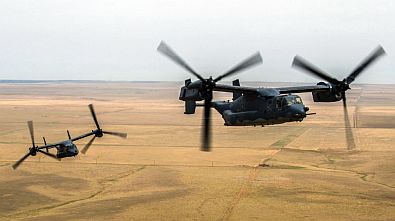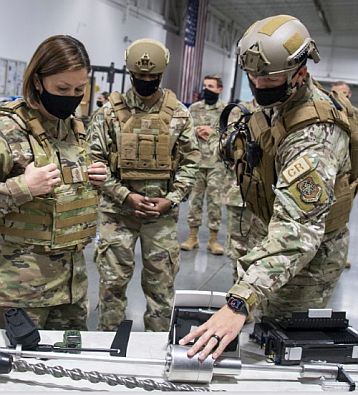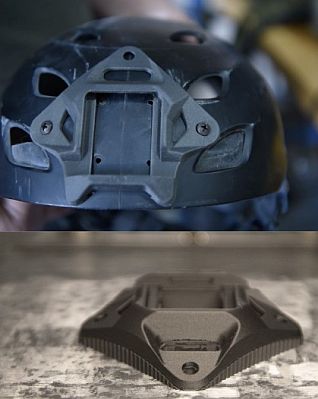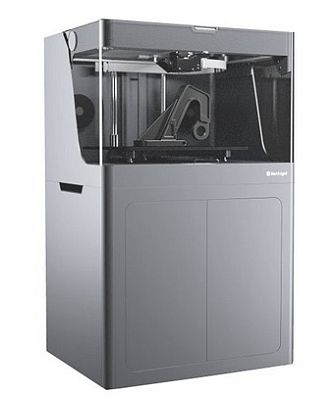U.S. Air Force Uses 3D Printer to Minimize Disruptions in Training Missions
One of the tasks for the Air Force's 27th Special Operations Wing in New Mexico is to conduct combat training missions. It's critical that equipment is reliable and available at a moment's notice. If a part or device breaks, now the team can often replace or repair it quickly by using a recently acquired 3D printer from Markforged.
Cannon Air Force Base, home of the 27th Special Operations Wing (27 SOW), lies in the high plains of eastern New Mexico, near the Texas Panhandle. The 27 SOW employs specialized aircraft and highly trained airmen to execute and support special ops missions around the world. Within the 27 SOW, the 27th Special Operations Support Squadron (27 SOSS) supports deployment, employment, planning, and combat training for specific squadrons and other flying operations.

Cannon Air Force Base is located in New Mexico, near the Texas Panhandle.
Every year, the 27 SOSS combat training unit sets up and executes more than 300 mission scenarios. "Our training facility offers the closest thing to an actual battle without it being life threatening," says Lejay Colborn, the 27 SOSS Range Support Planning and Operations Specialist, and a retired Navy Explosive Ordnance Disposal (EOD) technician.
A vast amount of equipment is needed to make each training scenario a reality. Colborn and his teammates must rapidly build devices and stage each environment to match specific combat zones. As part of this process, they use everything from technical and up-armored vehicles to simulated explosives and bombs.

Airmen typically carry packs of 80 lbs or more in combat training scenarios.
The 27 SOSS combat training section is all about readiness, relevance, and resiliency. They are responsible for ensuring their equipment is reliable and available at a moment's notice. If a part or device breaks, the team must quickly replace or fix it to minimize disruption of ongoing training missions.
Given the significant amount of wear and tear on combat equipment, the need for replacement parts is constant. Possibly more important than having fast access to replacement parts is having fast access to more durable and higher quality equipment. Many items used by the combat training section don't always fit the team's specific needs.

The usual helmet goggle replacement mount cost up to several hundred dollars with a shipping time of a few weeks or more. A 3D printed replacement mount costs less than $5 and can be produced in just a few hours.
As a result, they often have to modify equipment to make it more lightweight, durable, or add and enhance specific features. According to Colborn, he needs "equipment-grade materials and something high-temperature and high-strength -- like Onyx reinforced with fiberglass, carbon fiber and Kevlar, compared to a PLA or ABS machine." The goal is to deliver necessary replacement items on-the-fly and, when needed, customize -- or even create -- new items so they more readily fit whatever scenario the team is in.
Lejay Colborn had prior experience with 3D printing thanks to the on-site Air Force Repair Facility. He even used the facility printer for some smaller jobs. But as his section's demand for more sophisticated and durable parts increased, he decided to set up a 3D print shop within the combat training section. After extensive research, the squadron invested in a Markforged X7 printer. The benefits were almost immediate.

Markforged's X7 3D Printer
Airmen typically carry packs of 80 lbs or more in combat training scenarios. Under those circumstances, any load weight reduction goes a long way towards improving airman stamina and agility. The combat training unit decided to 3D print many of the tools used by airmen in the field. The tools, printed with Onyx -- a carbon fiber filled nylon material -- were more durable and lighter than their conventional counterparts.
Simulated combat, like real combat, can happen at any time of day -- or night. That's why most training kits include night vision goggles (NVGs). The goggles are held in place by NVG mounts affixed to the top-front of airmens' tactical helmets. Unfortunately, NVG mounts are vulnerable to damage due to user error and impact.
A single replacement mount can range from $100 to several hundred dollars with a shipping time of a few weeks or more. Colborn realized he could solve this issue with the unit's Markforged industrial X7 3D printer. The team used the CAD file to 3D print replacement mounts with built-in spacers to accommodate multiple helmets to include those used in force-on-force scenarios for less than $5 in just a few hours. According to Coborn, his 3D printed NVG mounts are "just as strong as the commercial, off-the-shelf aluminum ones."
VIDEO: Markforged X7 Field Edition Hilarious and Practical Demo
Prototyping with the X7 has also been a real game-changer in terms of improving combat training readiness. "I can print something out, test it, and see if it is going to work," says Colborn. "There's a huge cost savings. There's a huge time savings. There's a lot that makes it so worthwhile. Bringing in the Markforged printer is one of the best things we've ever done."
The combat training section continues to seek new ways to improve performance and accelerate innovation through 3D printing and design. Colborn plans to pass on to his teammates everything he learned through the Markforged Training on additive manufacturing via Markforged University.
The more airmen who have knowledge and experience with 3D printing technology, the more prepared and equipped the U.S. Air Force will be, both now and in the future. The combat training section has also recently acquired a Markforged Metal X system, which will help them create hybrid carbon fiber and metal parts for combat simulation systems.
Want more information? Click below.
Rate this article
View our terms of use and privacy policy ::m::